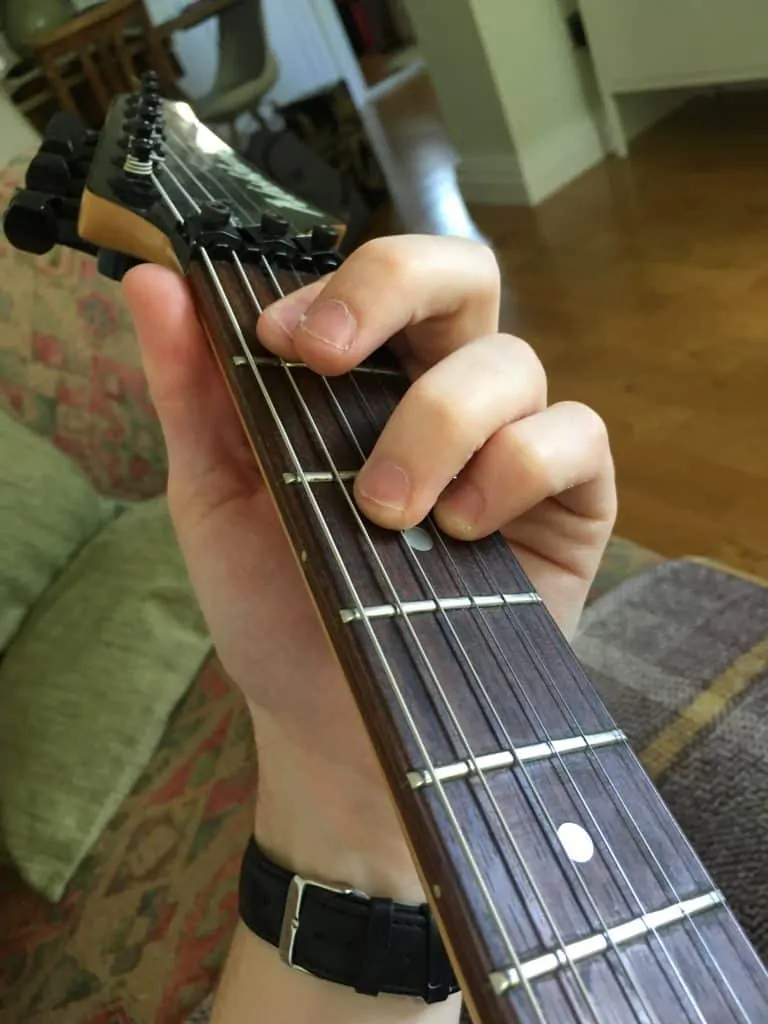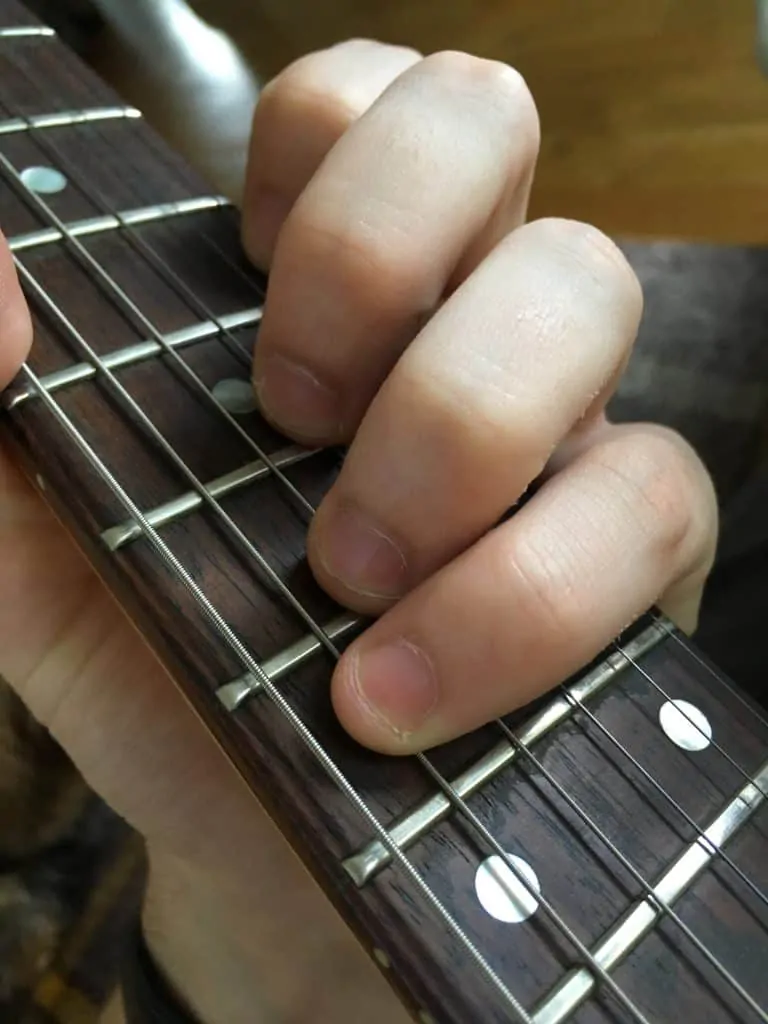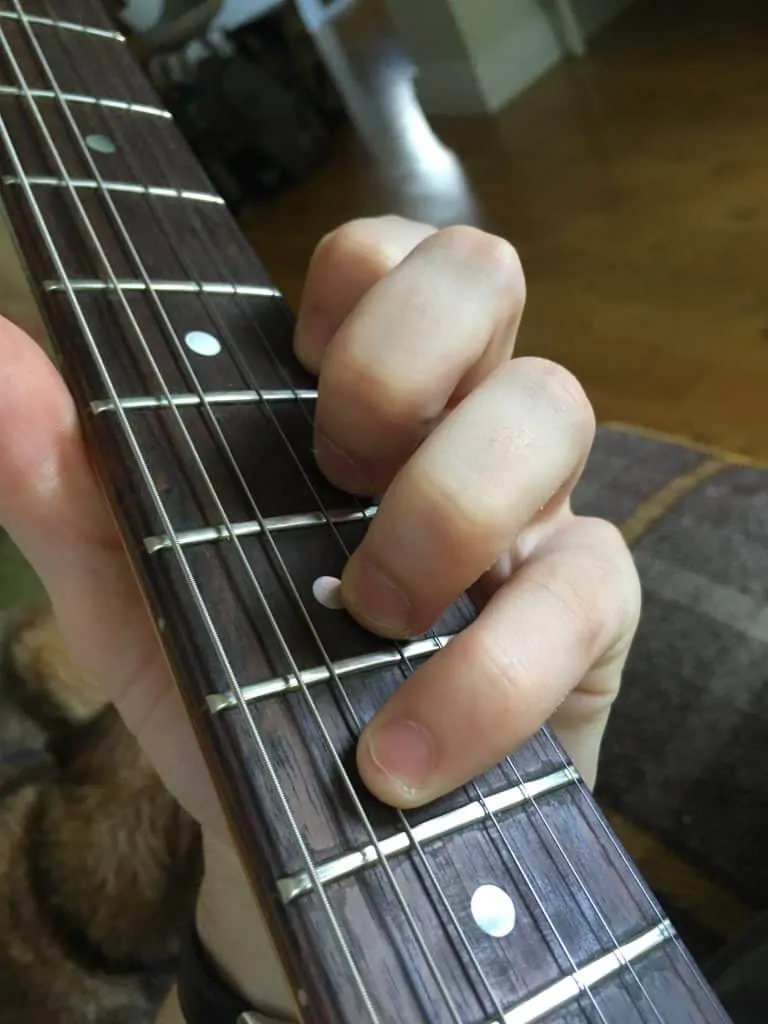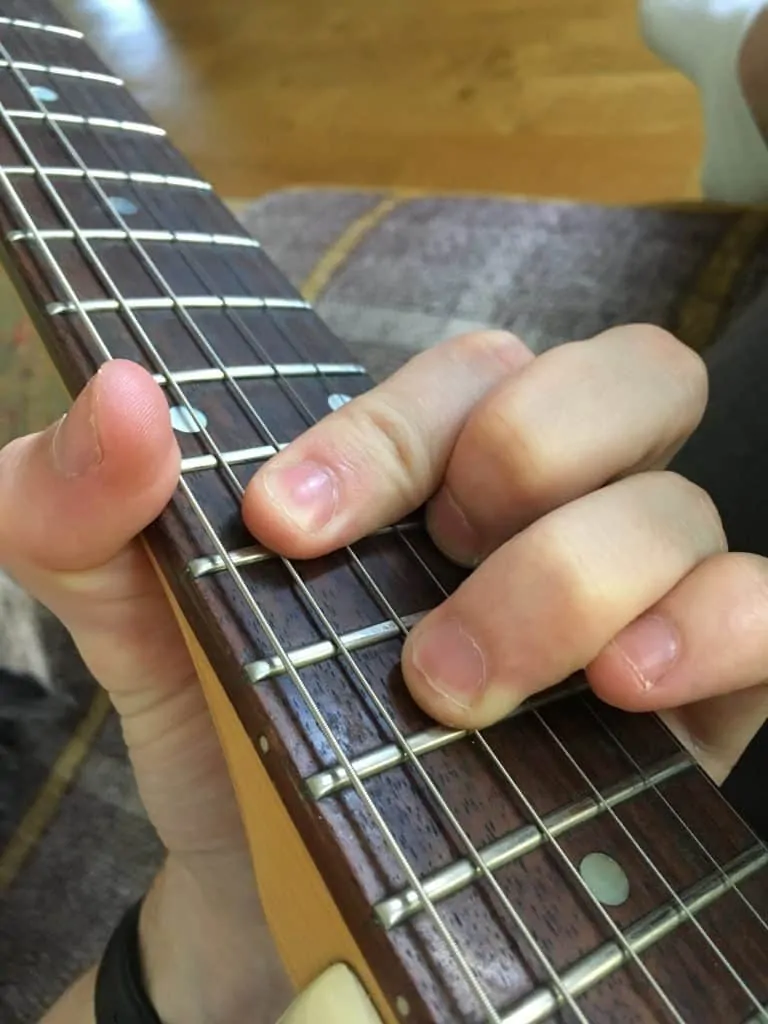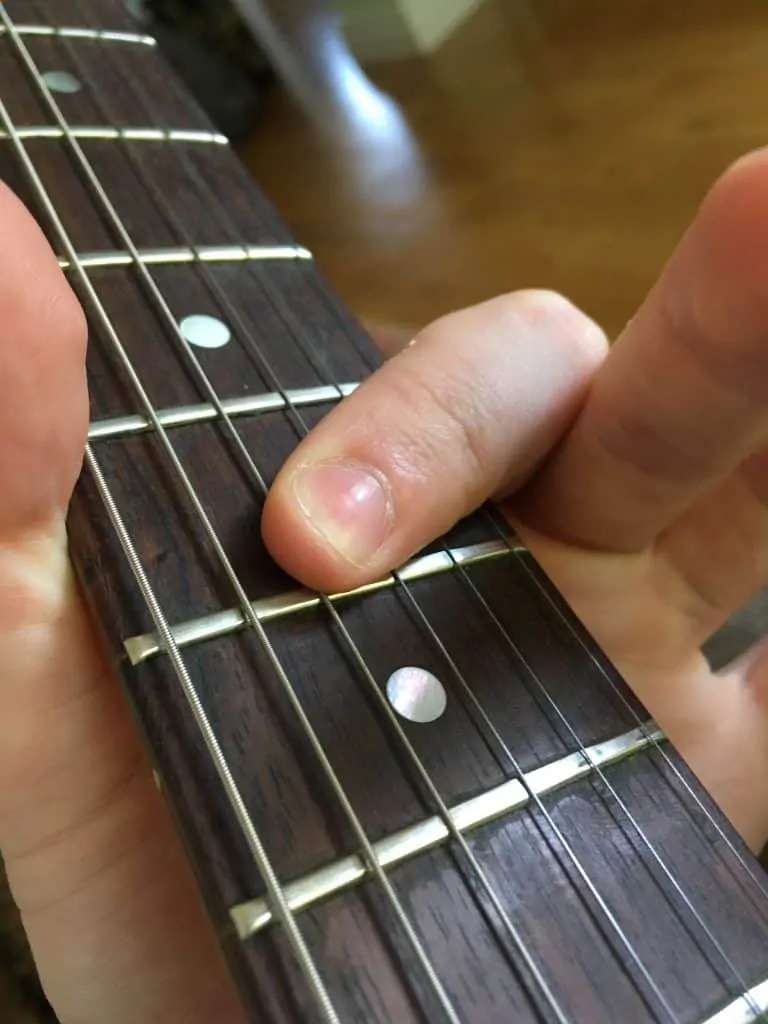Having already looked at ‘open’ chords and their simple shapes, it’s time to move towards some harder to grasp, rarer chords that are known as the ‘black notes’ on a piano.
In this important guide, I’ll be taking you through a huge number of variants of the A#/Bb chord:
If you’re looking for a place to start with A#/Bb chords, then look no further…
Contents
A#/Bb Major Chord
Every major scale has the same theory behind it, building on a pattern of tones between the notes: 1-1-1/2-1-1-1-1/2. On a piano, the ‘1’ means that if you’re starting on the C, then there will be one note (Eb in this case) between your C and the next note of the scale (D), while the 1/2 means that the next note of the scale is directly next door (such as in the move from E-F in C major). On a guitar, the 1/2 means the next fret is in the scale, and the 1 means there will be a fret in between the two notes.
A# major: A#, B#, C##, D#, E#, F##, G##
Bb major: Bb, C, D, Eb, F, G, A
You may have noticed that we’re looking at two scales here. Sort of… Technically an A# and a Bb are exactly the same, they just appear in different contexts. Hence why is you take a look at the scales above, each note is the enharmonic equivalent of each other, so if you played an A# major scale out of context, it would be completely impossible to determine whether it was A# or Bb.
For example, in a key with flattened notes, then you’ll (normally) be playing a Bb if you need to use that note, but in a key with sharps, then it’ll (normally) be an A#. As it only has two flats, Bb is much more common than A#, so we’ll approach most of the chords below from the Bb perspective.
Each of these notes (degrees of the scale) can be assigned a number as it ascends so you can use a helpful formula to work out chords from it. The A# is a 1, the B# is a 2 etc. while for Bb major, the Bb is a 1, the C is a 2 etc.
Once you’re familiar with the scale, you’ll do well to remember that the formula for an A# major chord (and any tonic major chord of any key) is 1-3-5 which gives the notes A#-C##-E# while the formula for a Bb major chord is 1-3-5 which gives the notes Bb-D-F.
Within the key of A#/Bb major, you can make various chord sequences and work them out using this numbering system, but remember that A#/Bb major is your tonic, and is where the key will sound resolved and at home.
Songs That Use A#/Bb Major Chords
There isn’t much point in choosing to play an A#/Bb chord specifically (unless it’s to house a singer’s range etc.) as the actual note isn’t really going to change the sound of the chord, just the pitch. However, the way you play your chord is important and will determine which styles each variation should be used in.
- Green Day- 21 Guns
- Coldplay- Paradise
- Queen- Bohemian Rhapsody
- Incubus- Drive
- Arctic Monkeys- Do I Wanna Know?
- Prince- Purple Rain
- Elton John- Rocket Man
- The Killers- Human
- Eminem- Love The Way You Lie
- The Fray- How To Save A Life
Playing A#/Bb Major
Variation 1
As you’ll have seen in various other guides on BeginnerGuitarHQ (such as C#/Db), we can always combine the classic E major open chord shape with a barre on any fret to bring the shape up. As this one is pretty low down the neck, it works well with open chord sequences on an acoustic guitar.
You’ll want to barre the 6th fret using your 2nd finger, then bring your 4th finger over to the 8th fret of string 5, your 5th finger to the 8th fret of the 4th string and then your 3rd finger to the 7th fret of the 3rd string.
Variation 2
Similarly to the above, we can also move our A major shape up a fair few frets with an added barre to create a nice well rounded shape. As this one is so much higher on the neck, it’ll work a lot between when combined with other similarly high barre chords.
Barre the 13th fret using your 2nd finger, then you have two options: either press your entire 4th finger across the 15th fret of strings 2, 3 and 4, or if you haven’t built up the strength for that yet, then use fingers 3, 4 and 5 to press fret 15 of strings 4, 3 and 2 respectively.
Variation 3
This is a nice easy one if you’re unable to make the full barre shape across the whole neck, and it also gives quite an easy option for muting/staccato playing.
Create a tiny barre on fret 6 of strings 1 and 2 using your 2nd finger, then stretch finger 3 over to the 7th fret of string 3 and your 4th finger over to the 8th fret of string 4. Make sure to mute the two lower strings.
Variation 4
By stretching the D major shape all the way up to the 8th fret, we can make a nice spread of notes that cover a large range of notes to make the chord sound really full.
Press down on the 8th fret of the 4th string using your 2nd finger, then press your 3rd finger down on the 10th fret of the 3rd string, your 5th finger onto the 11th fret of the 2nd string and your 4th finger onto the 10th fret of the 1st string.
A#/Bb Minor Theory
A minor scale differs slightly from a major scale in that degrees 3, 6 and 7 are all flattened, so they are lowered by one semitone. This creates the A#/Bb natural minor scale (variants such as the harmonic and melodic minor will be looked at in a separate guide).
A# minor: A#, B#, C#, D#, E#, F#, G#
Bb minor: Bb, C, Db, Eb, F, Gb, Ab
We could apply numbers to these much like we did with the major scale, so a minor chord would still be 1-3-5, like the major. But this is a bit confusing, so let’s approach it from the context of the major scale.
An A# minor chord is 1-b3-5, so therefore made up of the notes A#-C#-E#, while a Bb minor chord is Bb-Db-F.
Both A# and Bb minor keys are quite rare due to the high number of sharps and flats they both respectively have, but Bb is a lot more common than A#.
Songs That Use A#/Bb Minor
Again, rarely does a song seek to use the A#/Bb note specifically, but rather the minor chord itself. Whether it is as part of the key and therefore makes sense, or to bring out its sadder sound than a major chord, a minor chord is something important throughout all music.
- Labrinth- Jealous
- Ed Sheeran- I See Fire
- Shawn Mendes- Stitches
- Baby Queen- Red Light
- Rita Ora- Shine Ya Light
- Rihanna- Umbrella
- Red Hot Chilli Peppers- Torture Me
- Ellie Goulding- Burn
- Black Label Society- Funeral Bell
- Biffy Clyro- Victory Over The Sun
Playing A#/Bb Minor
Variation 1
As with the major variations shown above, the A#m chord is able to replicate the E minor open shape using a barre to bring it up a couple of frets. Again, this one will be easy to use in conjunction with lower, open chords.
Barre the 6th fret all the way across, then use your 4th and 5th fingers to press down on the 8th fret of strings 4 and 5. Make sure your barre is strong enough to bring out the 6th fret of string 3 as that provides the minor 3rd.
Variation 2
Again, we can move a nice variation of the A minor shape up by a lot of frets in order to get another nice new version of the Ab minor chord. This one will work well when you’re already playing barre chords in a similar position.
Use your 2nd finger to barre the 13th fret, then press your 3rd finger on to the 14th fret of string 2, your 5th finger onto the 15th fret of string 3 and your 4th finger onto the 15th fret of string 4.
Variation 3
This version is a nice easy one that you be may be familiar with thanks to a nice easy version of F major that exists just a few frets down. While not technically an open chord, the easy shape and low position of this variation makes this an easy one for beginners.
Use your 2nd finger to barre the 6th fret of strings 1, 2 and 3, and then bring your 4th finger over so that it is pressing down on the 8th fret of the 4th string.
Variation 4
This version of Bbm is one we don’t often look at here at BeginnerGuitarHQ, but its simplicity and ability to be used in metal (and anything with overdrive, really) music should not be understated.
Press your 4th finger down on the 6th fret of the 6th string and your 2nd finger down on the 4th fret of th 5th string. Make sure the remaining 4 strings are muted as you don’t want their dissonance ringing out.
A#/Bb7 Chord
An A#7/Bb7 chord, or A#/Bb dominant 7, is a major chord with an added minor 7th. This creates an interval of a tritone within the chord, adding a layer of dissonance to the sound. In a lot of music, the A#/Bb7 is used as part of a perfect cadence, in order to resolve to the tonic. However, one of the primary uses of the dominant 7th in modern music, is as a part of jazzy chord sequences.
If we use major scale theory (which we would unless you’re delving into the realm of modality where this chord has a strong Mixolydian quality) then the formula for this chord is 1-3-5-b7. The b7 takes the G## of an A# major scale down to a regular G#, or the A of a Bb major scale down to an Ab.
This means that the notes in a A#7 chord are A#-C##-E#-G#, while the Bb7 chord is made up of the notes Bb-D-F-Ab.
Songs That Use A#/Bb7
Both Bb and A# are relatively uncommon in popular guitar music as they form the highly dissonant tritone above E minor. However, in guitar music specifically aiming to achieve this dissonance, you’ll often find the Bb is the one creating the dissonance. The use of the dominant 7th gives a distinctive dissonance that allows the chord to be use in poignant parts of slower songs, while fit into jazzy, faster numbers.
- Alan Menken- Friend Like Me
- Donovan- Mellow Yellow
- Anders Matthesen- Pesto
- The Who- Bargain
- Norah Jones- Don’t Know Why
- Jimi Hendrix- Red House
- Elton John- Harmony
- Katie Melua- Piece By Piece
- Pharrell Williams- Happy
- Michael Bublé- Feeling Good
- Pink Floyd- Dogs
Playing A#/Bb7
Variation 1
This one is yet another repositioned version of the open E7 chord moved up by a good few frets. It creates a full sound, but you have to make sure you can keep the barre down with enough strength.
Use your 2nd finger to barre the 6th fret, then bring your 4th finger over to the 8th fret of string 5, and your 3rd finger to the 7th fret of the 3rd string. As I’ve said, make sure your barre is able to hold down the 6th fret of string 4.
Variation 2
This is another case of taking a classic, easy open shape and moving it up to a new fret and adding a barre underneath. In this case, we only have to take it up by one fret, from the open A7 chord to the barred 1st fret A#7 chord.
Use your 2nd finger to barre the 1st fret of the neck, then bring your 4th finger over to the 3rd fret of the 4th string, and your 5th finger to the 3rd fret of the 2nd fret. Again, make sure your barre keeps the 1st fret down on the 3rd string.
Variation 3
This option is a slightly weirder, less common shape that is pretty hard to move between and away from, but gives you arguably the perfect spread of notes to voice the chord.
Press your 2nd finger onto the 8th fret of the 1st string, your 3rd finger onto the 9th fret of the 3rd string, your 4th finger onto the 10th fret of the 4th string and your 5th finger onto the 11th fret of the 2nd string.
A#/Bbmaj7 Chord
An A#/Bbmaj7 chord is simply a major chord with a major 7th attached to the top. This often gives it a very uplifting sound, but there is an underlying dissonance due to the major 7th interval.
If we look at it from the point of view of the major scale algorithm, then the chord outlines a pattern of 1-3-5-7.
This means that the notes in an A#maj7 chord are A#-C##-E#-G##, while a Bbmaj7 chord is made up of Bb-D-F-A.
Songs That Use A#/Bbmaj7
A#maj7 is a good one when used in many contexts due to its ability to slot well into jazz and pop styles. Soul music also finds itself with a lot of maj7 chords chucked in throughout.
- Daniel Caesar- Best Part
- Norah Jones- Don’t Know Why
- Tyler, The Creator- Earfquake
- Coldplay- Poor Me
- J. Cole- Apparently
- Jett Rebel- Gwen
- George Harrison- Tears Of The World
- Pink Floyd- Eclipse
- John Martyn- Glory Box
Playing A#/Bbmaj7
Variation 1
This is my favourite way to play any version of any Bb chord, as it creates such a shimmering sound, while being surprisingly easy to play and move towards/from.
Press your 2nd finger onto the 5th fret of string 1, your 3rd finger onto the 8th fret of string 2, your 4th finger onto the 9th fret of string 3 and your 5th finger onto the 10th fret of the 4th string. Make sure the lowest two strings remain muted.
Variation 2
This variation is also able to bring a nice full sound to the chord thanks to It bringing the Amaj7 open shape all the way up the neck by adding a barre underneath it.
Barre the 13th fret (but mute string 6), then press your 4th finger onto the 15th fret of string 4, your 3rd finger onto the 14th fret of string 3 and your 5th finger onto the 15th fret of string 2.
Variation 3
This one gives you a lot of control over its staccato playings, as the bulk of the chord is made up of a barre that you’ll easily be able to lift up and down.
Use your 2nd finger to press down on the 8th fret of the 4th string, and then barre the 10th fret of strings 1, 2 and 3. Make sure the two lowest strings are muted.
A#/Bbm7 Chord
The A#/Bbm7 chord (A# minor 7) is based on a minor chord with a minor 7th above. It’s sort of the sadder version of the major 7th chord, giving off more of a negative sound due to the minor 3rd, but less dissonance due to the minor 7th interval instead of the major 7th.
If we look at it using the major scale formula, then it follows a pattern of 1-b3-5-b7.
This means that the notes in an A#m7 chord are A#-C#-E#-G#, while a Bbm7 is made up of the notes Bb-Db-F-Ab.
Songs That Use A#/Bbm7
Similarly to G#m7/Abm7, A#m7/Bbm7 can fit nicely into a lot of jazz music due its 7th interval, but equally it appears a lot in popular music styles as despite its dissonance, it has a pleasant tone.
- Blu Cantrell- I’ll Find A Way
- Gus Dapperton- My Favourite Fish
- Yebba- My Mind
- James Ingram- Just Once
- Sharon Cuneta- Parang Baliw
- Westlife- If I Let You Go
Playing A#/Bbm7
Variation 1
Like the major 7th equivalent shown above, we can bring an open A minor shape up a fair few frets and be left with quite an easy barred version of Bbm7 that will appear a lot in many songs.
Barre the 13th fret using your 2nd finger, then bring your 4th finger to the 15th fret of string 4 and your 3rd finger to the 14th fret of string 2. Make sure you’re pressing down hard enough on the 13th fret of string 3 in order to bring the minor 7th interval out fully.
Variation 2
If you’re looking for a variation of Bbm7 that is quite high up the neck and easy to play with various rhythms and styles, then go for this one. Funk playing in particular will be lent well to by this shape.
Press down on the 9th fret of the 1st and 2nd strings, then bring your 3rd finger to the 10th fret of the 3rd string. Mute the 3 remaining strings so that they avoid creating a muddy sound.
Variation 3
This is probably your easy option, but it does put the minor 7th interval at the bottom of the chord, which is a bit odd… but still this bridge shape is really good for funky playing.
Use your 2nd finger to barre fret 6 of the 1st, 2nd, 3rd and 4th strings.
Other A#/Bb Chords
There are a lot of other types of chords you can use based around your G#/Ab tonic. The ones I’ve shown you so far are probably the most common you’ll come across, particularly major and minor.
- Bbdim/E is one of the most dissonant chords possible to achieve on guitar as it puts the open low E string under a chord with its root a tritone away. If playing this in its lowest position, then the notes used are Fb[E]-Bb-Db.
- A#maj11 is a simple major 7th chord with the 4th of the scale added above. This adds an extra layer of dissonance that avoids being obtrusive on the delicate sound of the major 7th: A#-C##-E#-G##-D#.
- Bbaug is a strange chord that pushes the 5th of the chord up by a semitone, which often creates a really unusual and rare dissonance. In this case, the notes are Bb-D-F#.
There are obviously a lot more chords than this, but these are a few I really like. I have a few tricks to bear in mind when working out chords yourself.
- If you’re in an alternate tuning, remember these explanations won’t be the same!
- Using a formula to work out what notes are in a chord is a really simple way to help you out.
- When building chords that are hard to voice, the 5th is the first degree of the chord you are able to drop. Never drop the root, because that will normally completely change the chord you’re playing. For example, dropping the Ab from a Abmaj7 chord just makes C minor…
Good Luck!

Dan is a music tutor and writer. He has played piano since he was 4, and guitar and drum kit since he was 11.
He plays a Guild acoustic and a Pacifica electric. He has been sent to many festivals and gigs (ranging from pop to extreme metal) as both a photographer and reviewer, with his proudest achievement so far being an interview he has with Steve Hackett (ex-Genesis guitarist).
He ranks among his favourite ever guitarists, alongside Guthrie Govan, Jimmy Page, Jimi Hendrix, David Gilmour and Robert Fripp. His favourite genre of music is progressive rock, which he likes to use as a reference point in my teaching, thanks to its huge complexity in structure, rhythm and harmony. However, he is also into a lot of other genres including jazz, 90’s hip-hop, death metal and 20th century classical music.

